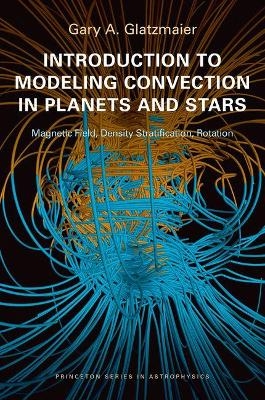
Introduction to Modeling Convection in Planets and Stars
Princeton University Press (Verlag)
978-0-691-14172-5 (ISBN)
This book provides readers with the skills they need to write computer codes that simulate convection, internal gravity waves, and magnetic field generation in the interiors and atmospheres of rotating planets and stars. Using a teaching method perfected in the classroom, Gary Glatzmaier begins by offering a step-by-step guide on how to design codes for simulating nonlinear time-dependent thermal convection in a two-dimensional box using Fourier expansions in the horizontal direction and finite differences in the vertical direction. He then describes how to implement more efficient and accurate numerical methods and more realistic geometries in two and three dimensions. In the third part of the book, Glatzmaier demonstrates how to incorporate more sophisticated physics, including the effects of magnetic field, density stratification, and rotation. Featuring numerous exercises throughout, this is an ideal textbook for students and an essential resource for researchers.
* Describes how to create codes that simulate the internal dynamics of planets and stars * Builds on basic concepts and simple methods * Shows how to improve the efficiency and accuracy of the numerical methods * Describes more relevant geometries and boundary conditions * Demonstrates how to incorporate more sophisticated physics
Gary A. Glatzmaier is professor of earth and planetary sciences at the University of California, Santa Cruz. He is a fellow of the American Academy of Arts and Sciences and a member of the National Academy of Sciences.
Preface xi PART I. THE FUNDAMENTALS 1 Chapter 1 A Model of Rayleigh-Benard Convection 3 1.1 Basic Theory 3 1.2 Boussinesq Equations 10 1.3 Model Description 13 Supplemental Reading 15 Exercises 15 Chapter 2 Numerical Method 17 2.1 Vorticity-Streamfunction Formulation 17 2.2 Horizontal Spectral Decomposition 19 2.3 Vertical Finite-Difference Method 21 2.4 Time Integration Scheme 22 2.5 Poisson Solver 24 Supplemental Reading 25 Exercises 25 Chapter 3 Linear Stability Analysis 27 3.1 Linear Equations 27 3.2 Linear Code 29 3.3 Critical Rayleigh Number 30 3.4 Analytic Solutions 31 Supplemental Reading 34 Exercises 34 Computational Projects 34 Chapter 4 Nonlinear Finite-Amplitude Dynamics 35 4.1 Modifications to the Linear Model 35 4.2 A Galerkin Method 36 4.3 Nonlinear Code 38 4.4 Nonlinear Simulations 43 Supplemental Reading 48 Exercises 49 Computational Projects 49 Chapter 5 Postprocessing 51 5.1 Computing and Storing Results 51 5.2 Displaying Results 51 5.3 Analyzing Results 54 Supplemental Reading 57 Exercises 57 Computational Projects 57 Chapter 6 Internal Gravity Waves 59 6.1 Linear Dispersion Relation 59 6.2 Code Modifications and Simulations 62 6.3 Wave Energy Analysis 66 Supplemental Reading 66 Exercises 67 Computational Projects 67 Chapter 7 Double-Diffusive Convection 68 7.1 Salt-Fingering Instability 69 7.2 Semiconvection Instability 72 7.3 Oscillating Instabilities 74 7.4 Staircase Profiles 76 7.5 Double-Diffusive Nonlinear Simulations 79 Supplemental Reading 80 Exercises 80 Computational Projects 80 PART II. ADDITIONAL NUMERICAL METHODS 83 Chapter 8 Time Integration Schemes 85 8.1 Fourth-Order Runge-Kutta Scheme 85 8.2 Semi-Implicit Scheme 87 8.3 Predictor-Corrector Schemes 89 8.4 Infinite Prandtl Number: Mantle Convection 91 Supplemental Reading 92 Exercises 93 Computational Projects 93 Chapter 9 Spatial Discretizations 95 9.1 Nonuniform Grid 95 9.2 Coordinate Mapping 97 9.3 Fully Finite Difference 98 9.4 Fully Spectral: Chebyshev-Fourier 102 9.5 Parallel Processing 108 Supplemental Reading 112 Exercises 112 Computational Projects 112 Chapter 10 Boundaries and Geometries 115 10.1 Absorbing Top and Bottom Boundaries 115 10.2 Permeable Periodic Side Boundaries 117 10.3 2D Annulus Geometry 122 10.4 Spectral-Transform Method 130 10.5 3D and 2.5D Cartesian Box Geometry 133 10.6 3D and 2.5D Spherical-Shell Geometry 135 Supplemental Reading 162 Exercises 162 Computational Projects 164 PART III. ADDITIONAL PHYSICS 167 Chapter 11 Magnetic Field 169 11.1 Magnetohydrodynamics 170 11.2 Magnetoconvection with a Vertical Background Field 173 11.3 Linear Analyses: Magnetic 179 11.4 Nonlinear Simulations: Magnetic 182 11.5 Magnetoconvection with a Horizontal Background Field 184 11.6 Magnetoconvection with an Arbitrary Background Field 187 Supplemental Reading 189 Exercises 190 Computational Projects 191 Chapter 12 Density Stratification 193 12.1 Anelastic Approximation 194 12.2 Reference State: Polytropes 207 12.3 Numerical Method: Anelastic 214 12.4 Linear Analyses: Anelastic 219 12.5 Nonlinear Simulations: Anelastic 222 Supplemental Reading 227 Exercises 227 Computational Projects 228 Chapter 13 Rotation 229 13.1 Coriolis, Centrifugal, and Poincare Forces 229 13.2 2D Rotating Equatorial Box 233 13.3 2D Rotating Equatorial Annulus: Differential Rotation 241 13.4 2.5D Rotating Spherical Shell: Inertial Oscillations 247 13.5 3D Rotating Spherical Shell: Dynamo Benchmarks 259 13.6 3D Rotating Spherical Shell: Dynamo Simulations 264 13.7 Concluding Remarks 275 Supplemental Reading 277 Exercises 278 Computational Projects 279 Appendix A A Tridiagonal Matrix Solver 283 Appendix B Making Computer-Graphical Movies 284 Appendix C Legendre Functions and Gaussian Quadrature 288 Appendix D Parallel Processing: OpenMP 291 Appendix E Parallel Processing: MPI 292 Bibliography 295 Index 307
| Reihe/Serie | Princeton Series in Astrophysics |
|---|---|
| Zusatzinfo | 16 color illus. 19 halftones. 23 line illus. 2 tables. |
| Verlagsort | New Jersey |
| Sprache | englisch |
| Maße | 152 x 235 mm |
| Gewicht | 680 g |
| Themenwelt | Mathematik / Informatik ► Mathematik ► Angewandte Mathematik |
| Naturwissenschaften ► Physik / Astronomie ► Astronomie / Astrophysik | |
| ISBN-10 | 0-691-14172-X / 069114172X |
| ISBN-13 | 978-0-691-14172-5 / 9780691141725 |
| Zustand | Neuware |
| Haben Sie eine Frage zum Produkt? |
aus dem Bereich


